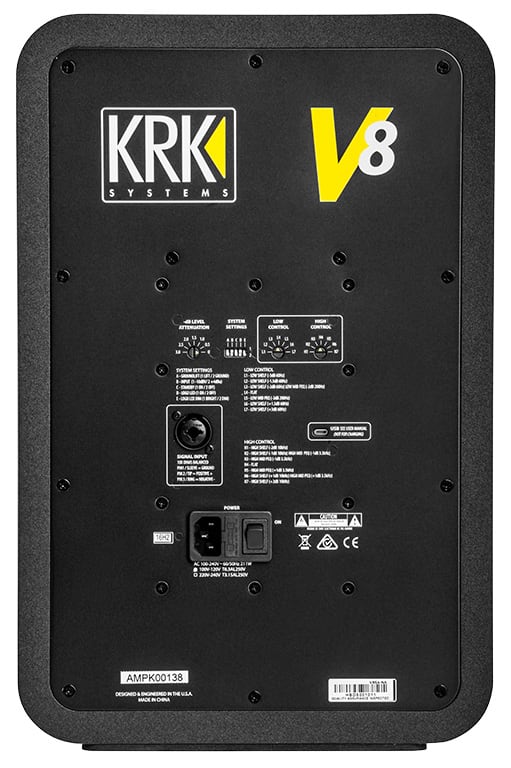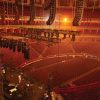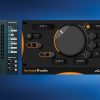
Review: KRK V8 Nearfield Monitors
KRK has re-released its flagship V series monitors, for a very keen price.
KRK monitors aren’t something I’ve had great experience with. Even so, I’m well aware of the impact KRK’s nearfield designs had on the Australian recording industry back in the early ’90s. At the time, it seemed like every second mix engineer was jumping on the KRK bandwagon. Admittedly, there wasn’t a lot of choice back then. Still, KRKs were a clear breath of air amongst the NS-10, Tannoy, and JBL monitors found in many studios at the time.
Delineating KRK from the stalwarts of the day was the use of woven Kevlar drivers, something not seen in the recording sphere until then. When KRK monitors first hit the meter bridges they rapidly gained fans who would extol KRK’s punchy bottom-end and precise yet unfatiguing high-end. Following my time with the latest incarnation of KRK’s flagship monitors I can affirm they do exactly that.
A GOOD GRILLING
The KRK V8 Series 4 is a front-ported, biggish monitor, and the largest in KRK’s range. Its measurements amount to 435 x 284 x 347mm. Weighing in at 14.4kg you’ll need a substantial set of stands to keep it in place, and like many monitors hitting the market at the moment, it has mounting bracket points. In addition there’s threaded inserts on the base of the cabinets for mounting on poles if that tickles your fancy.
The cabinets are primarily constructed of 19mm MDF. The drivers are housed in a cast plastic front baffle, which is finished with a brushed aluminium plate. The plate can be removed so you can install the provided protective grilles with a minimum of fuss. You wouldn’t install the grilles in a studio setting, but it’d be advisable for mobile recording and broadcast use. KRK claims there’s no sonic difference to the monitor’s frequency response with the grilles attached, but I beg to differ. I’ve never heard a set of monitors sound the same with grilles attached as when without, and to that end I had a go with the grilles on. While the difference is slight I’d still advise keeping them off if possible.
KILL THE RECOIL
Amplification is very typical of the current market; a class D design with 200W for low-end and 30W for the highs. An attenuator resides at the rear of the monitors for zero to -3dB attenuation in .05dB steps. KRK even supplies a tool for accessing and altering the mini-pots. Nice!
Attached to the base of the Series 4 monitors is an EVA foam cushion to stabilise the units. Apparently this aids in reducing the recoil of the low-end diver so as not to lose energy due to cabinet movement. Plus, it isolates the cabinet from its bench or stand to a degree.
As you’d expect, KRK utilises its woven kevlar bass drivers and soft-dome kevlar high-end driver. The design offers a unique ‘sound’ and has been KRKs schtick since day one. In the case of the V8s these drivers provide a 35Hz to 19kHz frequency response. The crossover frequency between high and low drivers is 1.8kHz for the V8s, 1.6kHz for the V6, and 2.1kHz for the V4s — no doubt all catered to with DSP. I’m a fan of the sound, and I’ve been considering a small pair of Rokit KRKs as an alternative monitoring system for some time.
NEED TO KNOW
FLIP THE SWITCH
I’m actually quite impressed with the features KRK has built into the Series 4 monitors. Aside from the grille on/off option, there’s a tonne of options when it comes to adjusting the EQ, and all the models in the range feature the same controls. All up there are 49 permutations of this digital EQ, and are adjusted via a five-position potentiometer for low-end and another for high-end. These are set curves comprising a mix of different amounts of low shelving at 60Hz and cut and boost PEQ at 200Hz, as well as a flat setting (thank goodness). The V8s arrived with the +3dB 60Hz firmly on, so I spent a couple of hours mired in bass before thinking there was a tad too much bum going on and checking on the EQ settings. The high-end adjustments consist of various combinations of high shelving at 10kHz and PEQ cuts and boosts at 3.5kHz, alongside a flat setting.
The V4 models are set with 75Hz low-end EQ curves rather then the V6 and V8 models being set at 60Hz, because four-inch drivers don’t, like, do 60Hz… ever. Anyway, there’s a pile of adjustment if you need it for wall proximity and/or console muddiness. But hey, I set them flat, because I don’t have a console and I don’t believe in equalising monitors.
Beside the EQ pots there’s also a set of dip-switches for, yes, more settings. These are to do with the mechanics of the system, and again, I’m impressed with the thought put into these features. First up, there’s a dip-switch for ground lift, which while helpful in a poorly-earthed system, amounts to a last minute fix for shoddy mains power wiring. The next dip-switch flips the monitor between -10dBV and +4dBu input levels — fair enough, standard fare. The next few dip-switches I love: The fourth and fifth switches turn the bright LED KRK logo on the front of the V8s on or off, or flip between two brightness settings — great if you don’t fancy blinding lights or if you like to mix in a darkened area.

IDLING ALONG
Switch number three is my favourite. This will instigate sleep mode for the monitors, which means the monitors will shut down after 30 minutes of not receiving signal input. I’d love a feature like this on my own monitoring as I tend to arc up my system during the day, and often keep it running until late evening. That’s 420W of amplification running for 10-12 hours a day, drawing around about 90W each in general use and about 35W when sitting idle. A sleeping monitor saves energy and consequently hard earned dosh. To wake up, all the monitor needs is -50 dBu at the inputs. However, it was a bit weird when the two V8s came back online about two seconds apart from each other. When it first happened, and knowing about the sleep function I thought I had a faulty or DOA monitor on my hands.
Another uncommon feature and something that’s yet to be deployed with the Series 4 KRKs is the mini USB port on the back of the monitors. KRK are keeping schtum about the use for this, other than pointing out the port “… is for possible future updates and/or features.” I can imagine this being implemented for alterations to the DSP-based EQ. Perhaps an app for more precise EQ nudges?
STAND UP IMAGE
Here’s something else you don’t see too often in monitoring — the Series 4 V model monitors are available in either black or an off-white cream colouring. The models I received were the white, which in all seriousness would not be my choice. Monitors should be black, or at least very very dark grey. The white models on my monitor bench were already showing signs of dirt and discolouration. I’ve no idea why you’d want white monitors, but as they say, different strokes, there’s no accounting for taste, etc, etc.
Sound-wise I have to say KRK do a great job with bottom-end. The Kevlar cones, combined with KRK’s square front porting, offer some very respectable and concise low-end, whilst high end is both accurate and unfatiguing. In terms of stereo imaging the V8s are quite a smart setup. The image ‘stands’ where it should with a minimal amount of set-up and ‘toeing’. I quite liked the V8s, and could happily live with a pair were I not over-endowed with monitors. When being informed of the price for the V8s I was astounded. For the money, at the moment I don’t believe you’d find a better bang-for-buck proposition. Impressive sound and imaging, plenty of customisation, and some change out of a two-grand investment. Well worth your auditioning.
You have the chance to win a pair of KRK V8s. Just subscribe to AudioTechnology’s print edition by the 31st of October, 2018, and answer the subscription prize question to go in the running. Thanks to Jands for this amazing prize. Subscribe here.






























RESPONSES